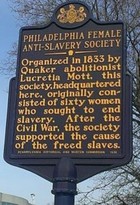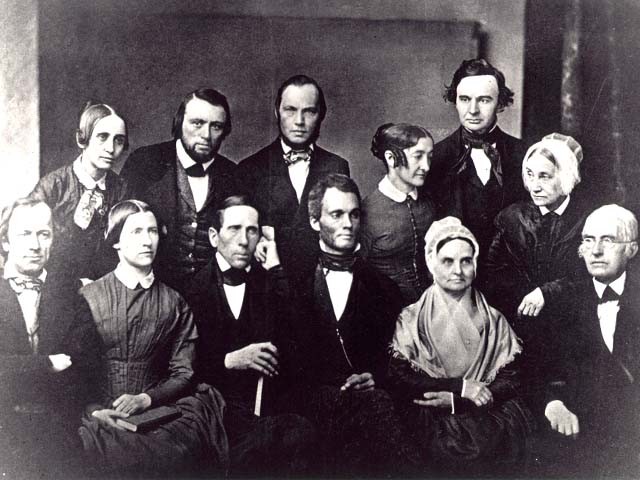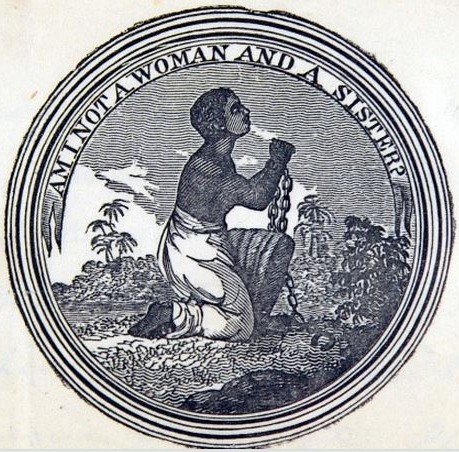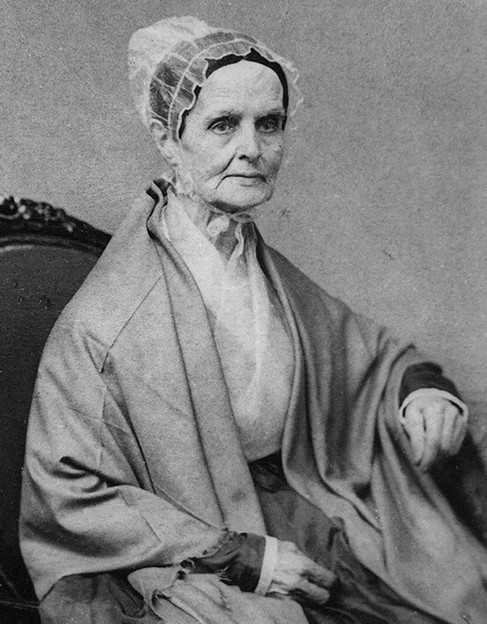Philadelphia Female Anti-Slavery Society Historical Marker
Introduction
Text-to-speech Audio
Images
The historical marker, at the original meeting location, recognizing the efforts of the Philadelphia Female Anti-Slavery Society.

A photograph of several of the key members of both the Philadelphia Female Anti-Slavery Society and the Philadelphia Anti-Slavery Society. The PFASS was created by women who were frustrated by not being allowed to serve as delegates in the male only PASS, but the two organizations went on to work together closely for several decades.

The seal of the Philadelphia Female Anti-Slavery Society.

An image of Lucretia Mott, a key member in the Philadelphia Female Anti-Slavery Society. The Quaker preacher was one of the founders of the organization and is recognized as one of the most important figures in the Women’s Rights Movement.

Backstory and Context
Text-to-speech Audio
In December of 1833, the Philadelphia Female Anti-Slavery Society (PFASS) was founded with the purpose of rallying support for the abolishment of slavery. While many abolitionist groups already existed at this time, most excluded women in favor of an all male membership. Lucretia Mott attended and spoke at the meetings of these organizations, but became frustrated that she could not become a delegate. With the assistance of 21 other prominent women within the community, she founded the Philadelphia Female Anti-Slavery Society in a Philadelphia schoolroom. The PFASS circulated flyers and petitions to rally support for their cause. As early as 1836, they lobbied congress to enforce emancipation and fundraised a large amount of money for other anti-slavery societies. While other female anti-slavery societies existed, the PFASS became the national focal point for female anti-slavery societies and hosted several national conventions to facilitate their interaction.
Lucretia Mott was one of the central figures in the Philadelphia Female Anti-Slavery Society. She was born as Lucretia Coffin on the island of Nantucket on January 3rd, 1793. The Coffin family was respected on the tiny whaling island. Like most of the population of Nantucket at this time, the Coffins were devout Quakers. At the age of 13, Lucretia was sent to New York to attend a Quaker school. Following her graduation, she became a teacher at the same school and eventually married James Mott, a fellow teacher at the school. The couple moved to Philadelphia and became closely involved in the budding social reform movements within the city. By this time, Lucretia was a respected Quaker preacher and a powerful voice for abolitionist and feminist movements.
In the winter of 1833, 22 women gathered in a Philadelphia schoolhouse for the founding meeting of the Philadelphia Female Anti-Slavery Society. Like other abolitionist groups, they campaigned to convince the public as well as lawmakers of the immorality of slavery. The inspiration for its creation came from the exclusion of Mott and other women from a notable anti-slavery convention. They decided that creating their own organization would allow them to fight for their cause. Their constitution stated “We deem it out duty, as professing Christians to manifest our abhorrence of the flagrant injustice and deep sin of slavery by united and vigorous exertions.” For the next three decades, the organization functioned as an integral part of the northern abolitionist movement.
The Philadelphia Female Anti-Slavery Society primarily fulfilled their mission by fundraising for the American Anti-Slavery Society, the organization that many of their husbands served as delegates in. However, they also directly communicated with Pennsylvania lawmakers and spread awareness among the public. Their impressive financial contributions alone kept several abolitionist groups functioning. Also, they secretly supported groups dedicated to hiding fugitive slaves despite internal conflict over the legitimacy of this strategy. Members of the PFASS could often be seen going door to door to persuade people to support the abolitionist movement. This grassroots propaganda strategy was notable as it challenged social norms at the time.
The Philadelphia Female Anti-Slavery Society dissolved in 1870 following the ratification of the 15th amendment. Of course, its primary accomplishment was the abolishment of the practice of slavery in the United States. However, scholars point to the PFASS as a stepping stone in the women’s suffrage movement. Several members, including Lucretia Mott, went on to be pivotal figures in that movement. Also, the foundation of the group and its work over the years reflected a significant change from prior social norms. While notable female orators had lended their voices to reform movements in the past, none had achieved the official recognition that the members of PFASS fought to earn. By the end of the anti-slavery movement, women like Mott who were initially excluded had cemented their place as key abolitionists. They took the respect their work had earned and channeled it into the women’s suffrage movement.
Sources
“Lucretia Coffin Mott.” 2019. Columbia Electronic Encyclopedia, 6th Edition, November, 1.
Jeffrey, Julie Roy. “‘Stranger, Buy… Lest Our Mission Fail:’ The Complex Culture of Women’s Abolitionist Fairs.” American Nineteenth Century History 4, no. 1 (Spring 2003): 1–24. doi:10.1080/14664650312331294244.
Asaka, Ikuko. “Lucretia Mott and the Underground Railroad: The Transatlantic World of a Radical American Woman.” Journal of the Early Republic 38, no. 4 (Winter 2018): 613–42. doi:10.1353/ jer.2018.0067.
Chmielewski, Wendy E. “Lucretia Mott’s Heresy: Abolition and Women’s Rights in Nineteenth-Century America.” Peace & Change 40, no. 1 (January 2015): 127–28. doi:10.1111/pech.12105.
Michals, Debra “Lucretia Mott.” National Women’s History Museum. 2017. www.womenshistory.org/education-resources/biographies/lucretia-mott.
HATCHER, EMILY. 2011. “The Philadelphia Female Anti-Slavery Society and the Civil War.” Pennsylvania Magazine of History & Biography 135 (4): 528. https://search.ebscohost.com/login.aspx?direct=true&db=edo&AN=66861350&site=eds-live.
“Women of the Anti-Slavery Movement.” Young America Republic. Omeka. Accessed February 14, 2020. http://projects.leadr.msu.edu/youngamerica/exhibits/show/womenabolitionists/womenledorgs.
“Philadelphia Female Anti-Slavery Society Historical Marker.” ExplorePAHistory. WITF. Accessed February 14, 2020. https://explorepahistory.com/hmarker.php?markerId=1-A-105.
African American Registry
Public Broadcasting Service
Wikipedia
Britannica
